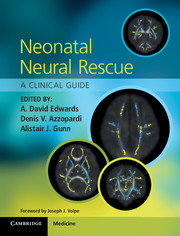Book contents
- Frontmatter
- Contents
- List of contributors
- Foreword
- Section 1 Scientific background
- 1 Neurological outcome after perinatal asphyxia at term
- 2 Molecular mechanisms of neonatal brain injury and neural rescue
- 3 The discovery of hypothermic neural rescue therapy for perinatal hypoxic–ischaemic encephalopathy
- 4 Clinical trials of hypothermic neural rescue
- 5 Economic evaluation of hypothermic neural rescue
- Section 2 Clinical neural rescue
- Section 3 The future
- Index
- References
1 - Neurological outcome after perinatal asphyxia at term
from Section 1 - Scientific background
Published online by Cambridge University Press: 05 March 2013
- Frontmatter
- Contents
- List of contributors
- Foreword
- Section 1 Scientific background
- 1 Neurological outcome after perinatal asphyxia at term
- 2 Molecular mechanisms of neonatal brain injury and neural rescue
- 3 The discovery of hypothermic neural rescue therapy for perinatal hypoxic–ischaemic encephalopathy
- 4 Clinical trials of hypothermic neural rescue
- 5 Economic evaluation of hypothermic neural rescue
- Section 2 Clinical neural rescue
- Section 3 The future
- Index
- References
Summary
Introduction
It was nearly 150 years ago that an association between perinatal events and brain injury was first reported, claiming that “the act of birth does occasionally imprint upon the nervous and muscular systems of the infantile organism very serious and peculiar evils” [1]. While a great deal is now known about this association and the pathophysiology behind it, the quantification of these “evils” is still uncertain. While the World Health Organisation estimates that 25% of neonatal and 8% of all deaths under 5 years in low-income countries are due to birth asphyxia [2], there remains no agreed definition; therefore, the reported prevalence varies. Consequently, the number of infants exposed is unknown, although approximately 7% of term infants require resuscitation after birth [3]. It is well recognized that only a small proportion of these infants will go on to develop neurological signs in the neonatal period and an estimated 2 per 1000 births in the developed world [4] will develop neonatal encephalopathy.
While encephalopathy is, therefore, relatively uncommon, the outcome can be devastating to the infant and family and it remains a major cause of death and long-term disability with a substantial burden on the community as a whole. It is estimated that each infant with complex neurological sequelae will cost the state over 1 million US dollars (800,000 Euros) in health care, social support and lost productivity throughout their lifetime [5]. In addition, unmeasured impacts on behaviour, school failure and psychiatric disease are likely all to have additive effects. As well as the direct costs, other population impacts are also likely. Increasingly literature suggests a causal link between IQ and lifespan [6] and the true cost to society of perinatal asphyxia is likely to be extensive.
- Type
- Chapter
- Information
- Neonatal Neural RescueA Clinical Guide, pp. 1 - 15Publisher: Cambridge University PressPrint publication year: 2013
References
- 1
- Cited by



